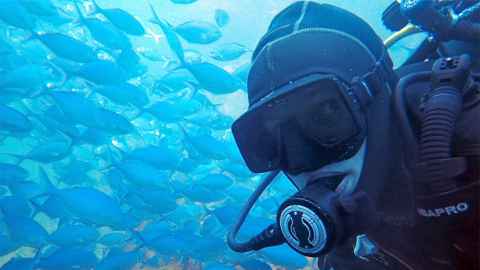Taking stock 40 years after marine reserve created
6 July 2020
Total biomass within the Leigh Marine Reserve is five times higher than it was 40 years ago when the Reserve was first established, a new study shows.

PhD candidate Harry Allard from the University of Auckland’s Institute of Marine Science conducted a three-year survey of 22 fish species within the Reserve, 10 of them targeted by fishers. Finishing the survey in 2018 meant it was exactly forty years since a 1978 study which established a baseline for future research.
Both old and new studies were similar in approach, using biomass as a measuring tool which takes into account both outright numbers and size of individual organisms. Mr Allard counted fish at similar locations to the previous study.
However he also surveyed 12 fished (unprotected) sites outside the Reserve which wasn’t done 40 years ago.
Results showed snapper were on average six centimetres larger in the Reserve than in fished areas outside but overall numbers within the Reserve have remained stable while the number of juvenile fish has decreased.
Red moki and butterfish – both favoured by spear divers - were also larger in the Reserve than in fished areas but numbers in the Reserve had also remained stable since 1978. While red moki were similar in abundance compared to forty years ago, total biomass of the species had increased with a greater number of legal-sized (more than 40cm) fish.
“Overall the data showed the marine environment within the Reserve is now dominated by fewer, larger fish with most of these being of prime breeding age,” Mr Allard says. “The offspring of these fish are now seeding areas outside the Reserve.”
Numbers of three target species included in the study, parore, leatherjacket and blue cod, were more abundant inside the Reserve than in fished areas but showed a decline in numbers overall since 1978. This could be due to wider environmental factors or the fact sea urchin barrens – areas with a high number of kina or sea urchins – have been widely replaced by kelp forests suiting some species but not others.
“This may reflect larger-scale changes in the Hauraki Gulf rather than local effects, perhaps due to warming winter temperatures,” Mr Allard says. “Blue cod were still larger and more numerous within the Reserve than fished areas outside which shows protection of this species may be increasingly important.”
There were fewer juvenile leatherjackets within the Reserve but still more than outside, with a similar finding for parore but large-scale changes due to climate change could also be a factor, Mr Allard says.
One of the most notable changes since 1978 was the replacement of sea urchin barrens with kelp forest and algae species, a sure sign that kina predators such as larger snapper are more numerous in the Reserve.
Three species, hiwhiwi, spotty (a common wrasse species) and goatfish, all showed a decline in numbers within the Reserve compared to fished areas outside. This might be due to a decrease in sea urchin areas or could point to increased predation by the higher number of larger fish within the Reserve.
Overall six out of ten species targeted by fishers showed positive growth in either weight or abundance in the Reserve over the past 40 years but Mr Allard says further research is needed to investigate longer term changes in the wider marine environment such as those caused by climate change.
However the research does undermine reports from the public there are fewer fish in the Reserve than there used to be.
“The fish are still there but they don’t come into shore anymore for a feeding frenzy of peas and bread now that feeding is banned,” he says.
“But it’s amazing how long a snapper’s memory can be, some of the older fish still follow people around expecting food.”
During research dives Mr Allard regularly saw the Reserve’s most famous resident, “Monkey Face” the snapper, estimated to be at least 40 years old. However the last time he saw him was 2018 and he’s heard that other divers haven’t seen him for some time.
“It may be he’s finally gone to that big marine reserve in the sky.”
Media contact
Anne Beston | Media adviser
DDI 09 923 3258
Mob 021 970 089
Email a.beston@auckland.ac.nz